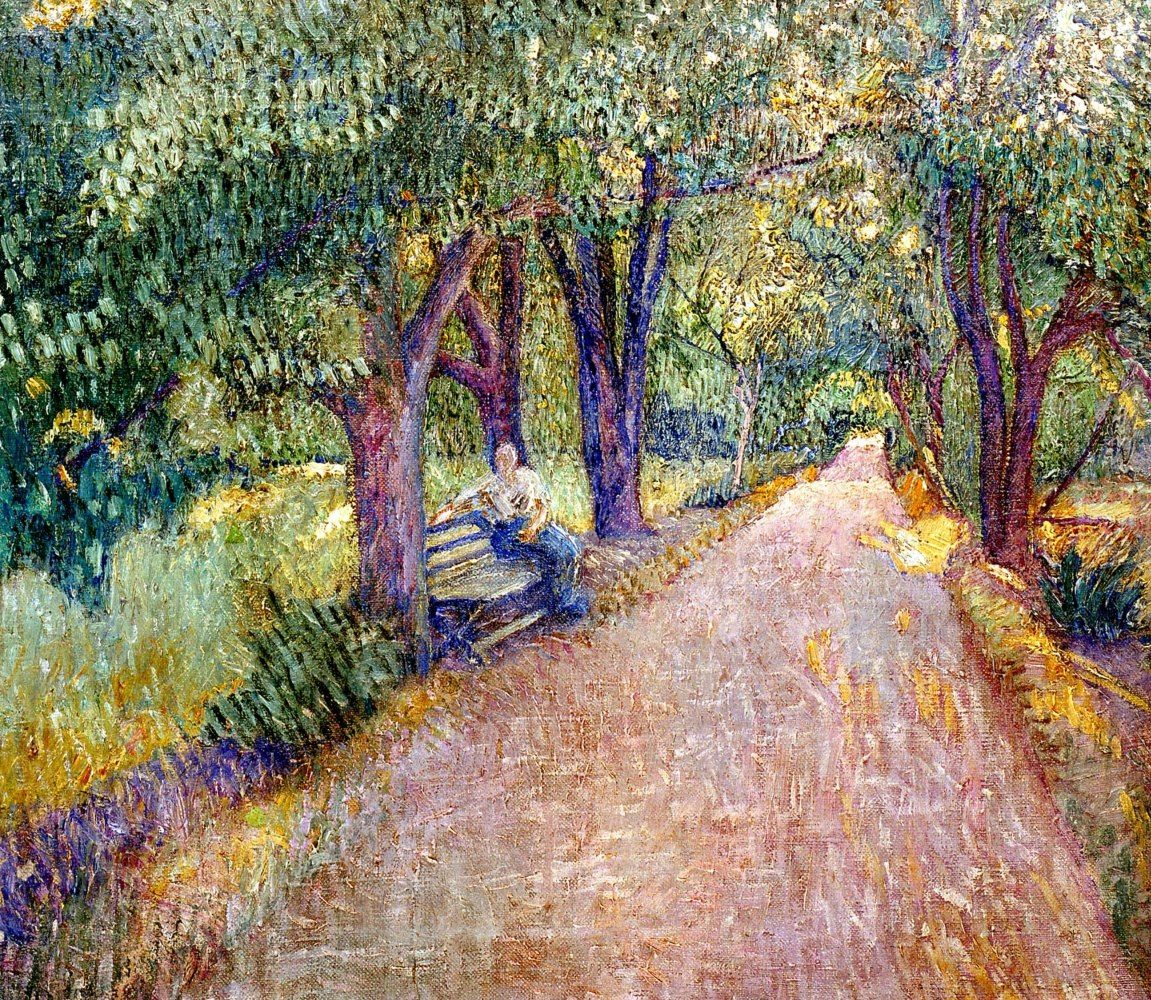
The Art of the Ukraine. David Burliuk
28.11.2023 by Oleksandra Sakorska
At the beginning of April 2022, the Liebermann-Villa was able to create a position in our team for a new assistant curator, Oleksandra Sakorska, who previously worked for ten years at the Khanenko National Museum of Art in Kyiv. The position was made possible by the UKRAINE-funding program of the Ernst von Siemens Kunststiftung.
In this blog series Oleksandra Sakorska will introduce us to some of the most important and most interesting names in Ukrainian art history, from the late nineteenth-century onwards. This second text will deal with the Ukrainian painter David Burliuk (1882-1967).
The Ukrainian version can be found below.
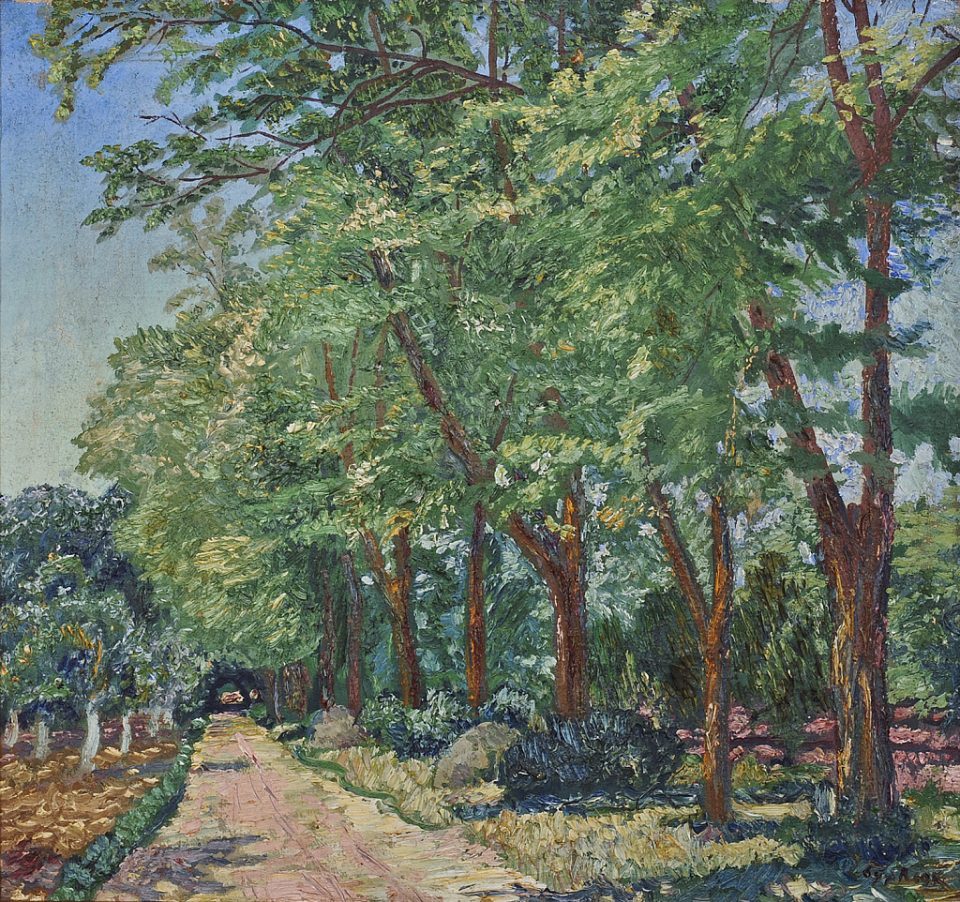
David Burliuk, Alley, 1909, Serpukhov History and Art Museum, Russia
Like Max Liebermann, Burliuk was one of the leading representatives of Impressionism in his country. Burliuk later developed a different, more avant-garde style of painting, but kept naming “Impressionism as a starting point for the renewal of art” (D. Burliuk. The Voice of Impressionist in Defense of painting. 1908).
The Ukrainian father of Russian futurism
David Burliuk (1882, Kharkiv Governorate, Russian Empire – 1967, Long Island, USA) was widely acknowledged during his lifetime as the “founder of russian futurism” and this title stuck with him throughout art history. Burliuk was born in a large Cossack-rooted Ukrainian family in the Kharkiv Governate, now in eastern Ukraine. As a child, David was accidentally shot in the eye by his brother while playing with a toy gun. Subsequently, David’s glass eye became part of his style. Burliuk was attracted to art from a very early age. He studied in the Odessa Academy of Art from 1900 to 1901 where he “began to paint and could not stop” (Burliuk D. “Fragments from the Memories of a Futurist». Saint-Petersburg, 1994), returning to the Academy in 1910 for one year. With his family’s support he was also able to study at the Academy of Fine Arts in Munich (1902) and later in the Atelier Cormon, Paris (1904). Burliuk’s first exhibitions were held in Kharkiv, Kherson and Odessa during 1906-1907 and in 1908 in Kyiv. There he showed his watercolors, pastels and drawings. Burliuk occasionally explored Ukrainian themes in his work. Although he spent much time abroad, he never completely forgot his roots.
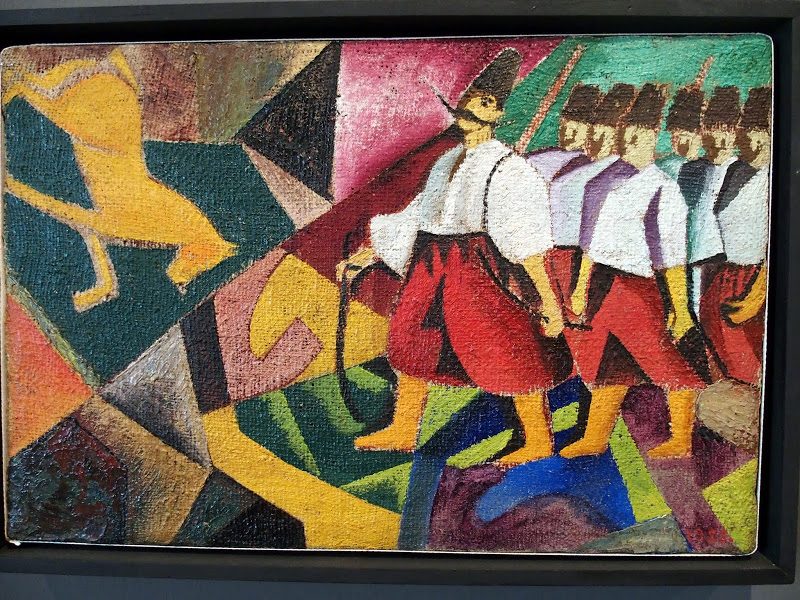
David Burliuk, Ukrainians, 1912, The State Russian Museum, Saint-Petersburg
The leader of the new wave
Burliuk played a particularly important role in consolidating creative searches and uniting innovative artists. As an active member of the left, controversial art movement, Burliuk famously described one of his artistic projects as “A slap in the face of public taste”(eponymous almanac, 1912). Burliuk was at the core of an artistic movement in the Russian Empire which aimed to develop new ways for expressing their creativity. Later, all members of the group began to name themselves futurists – prophets of the new age, who see, hear, read what is not yet available to anyone, but will soon be available to everyone, as it comes from their numerous performances and literature oeuvre.
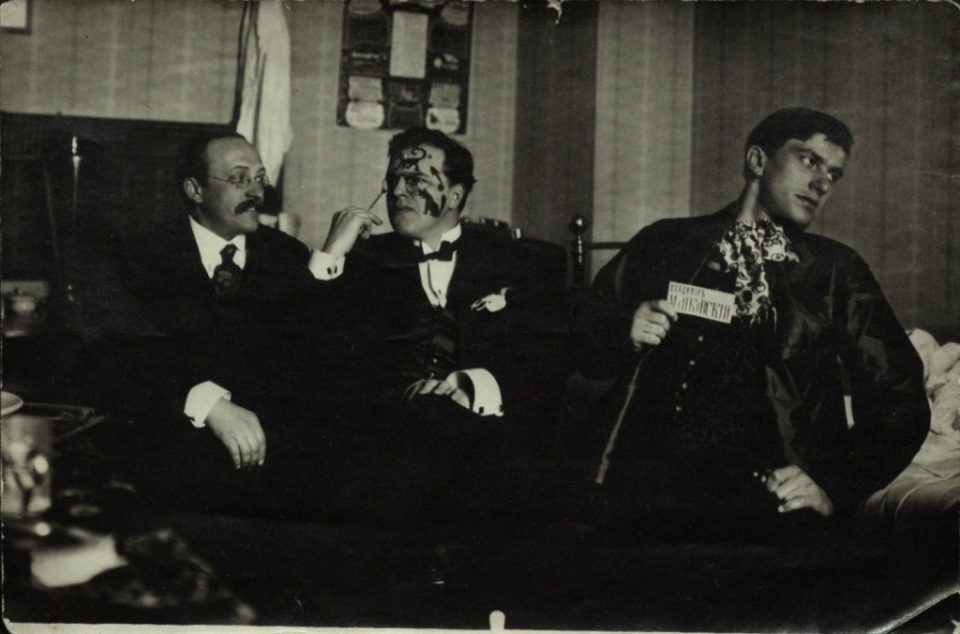
“Futurists Prophets” (Andrei Shemshurin, David Burliuk, Vladimir Mayakovsky), 1914, Anna Akhmatova Literary and Memorial Museum, Russia
This new ideology reflected the radical changes taking place in society at the beginning of the 20th century and was widely known as the Futurism movement, developed simultaneously in Italy and the Russian Empire.
Years in Exile
During the First World War Burliuk was not eligible for military service because he only had one eye. In 1918, Burliuk miraculously escaped death during the pogroms and executions of anarchists in Moscow. He quickly understood that there was no place for him in Soviet Russia. Therefore he planned exhibitions in the Ukraine specifically “to spite muscovites” [v piiku moskaljam].
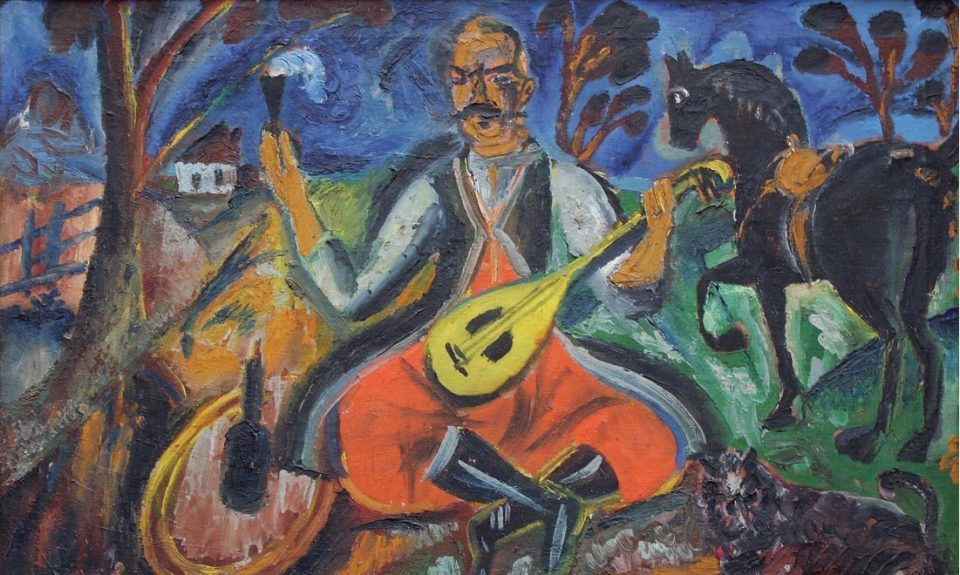
David Burliuk, Cossack Mamay, 1912-1916, Bashkir Nesterov Art Museum, Ufa
Shortly following the Russian Revolution Burliuk became one of the first ambassadors of the Russian-Ukrainian avant-garde abroad. In 1920, he emigrated to Japan where he made and sold paintings of local motifs, collecting money for a trip to the USA.
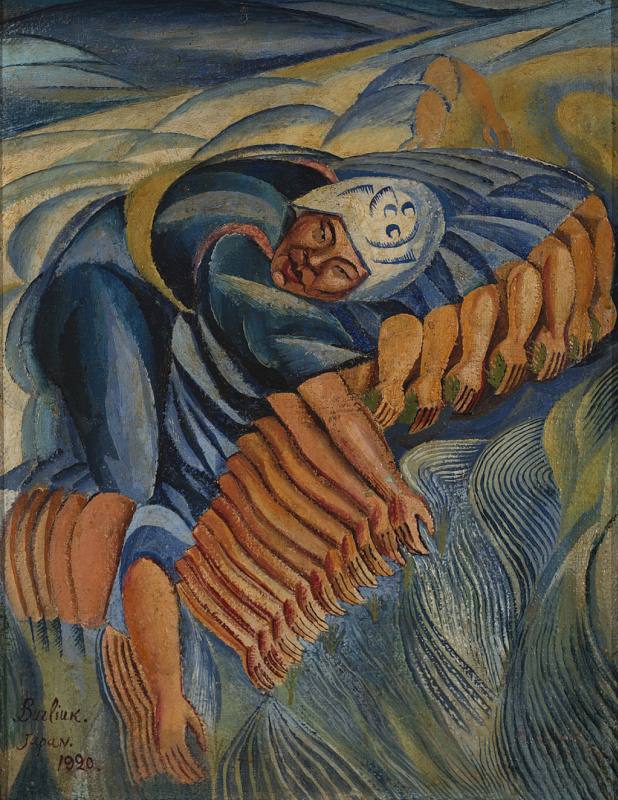
David Burliuk, Japanese woman sowing rice, 1920, Private collection
He finally moved to America in 1922 where he began writing poetry and publishing books. From 1930 Burliuk published the Russian-English magazine «Color & Rhyme», which existed until 1966. In the USA, he was also supported by the Jewish community, as Burliuk’s mother was Jewish– a fact not widely known nowadays. In 1949, he traveled to the south of France to visit the places where Vincent Van Gogh (1853-1890) had worked. After his death in 1967 Burliuk posthumously became a member of the American Academy of Arts and Letters, New York City (along with Leonard Bernstein, Henry Miller, Marcel Duchamp and others).
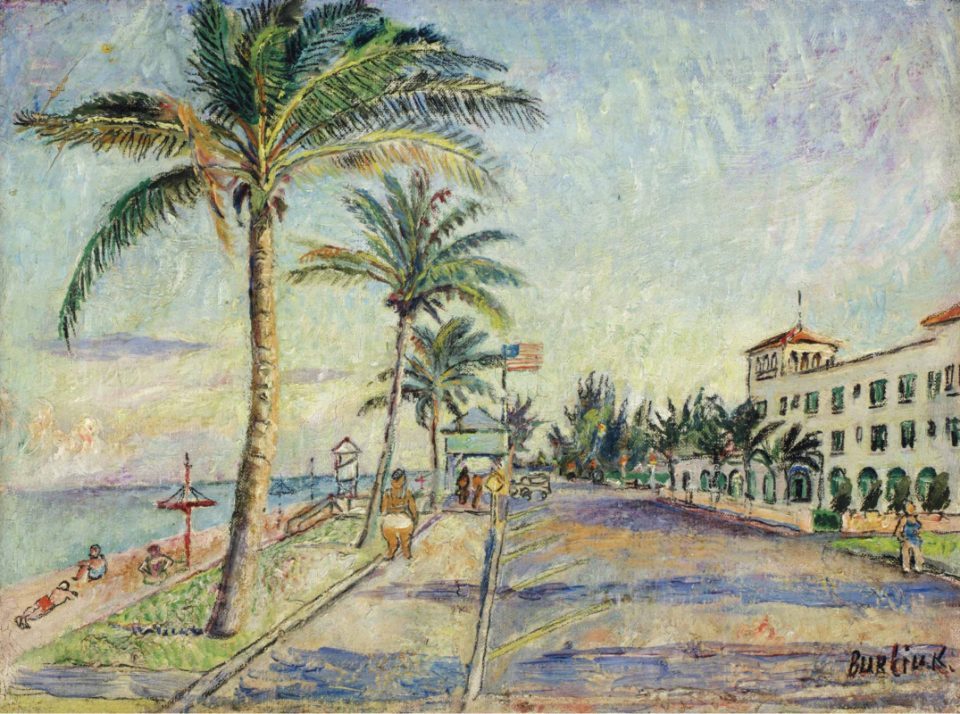
David Burliuk, Landscape, 1950s, Private collection
Experiments and connections
Burliuk loved to experiment and was among the first painters to use a collage technique, incorporating a wide range of items, from glued pieces of plywood to gears and metal plates. In his artworks Burliuk cherished texture in every possible way. He also used very bright colors in the style of patchwork quilts, combining cubism and folk art. In general, he considered a painting to be a means of communication that could be understandable and interesting to everyone and therefore could claim to be universal, rather than elitist.
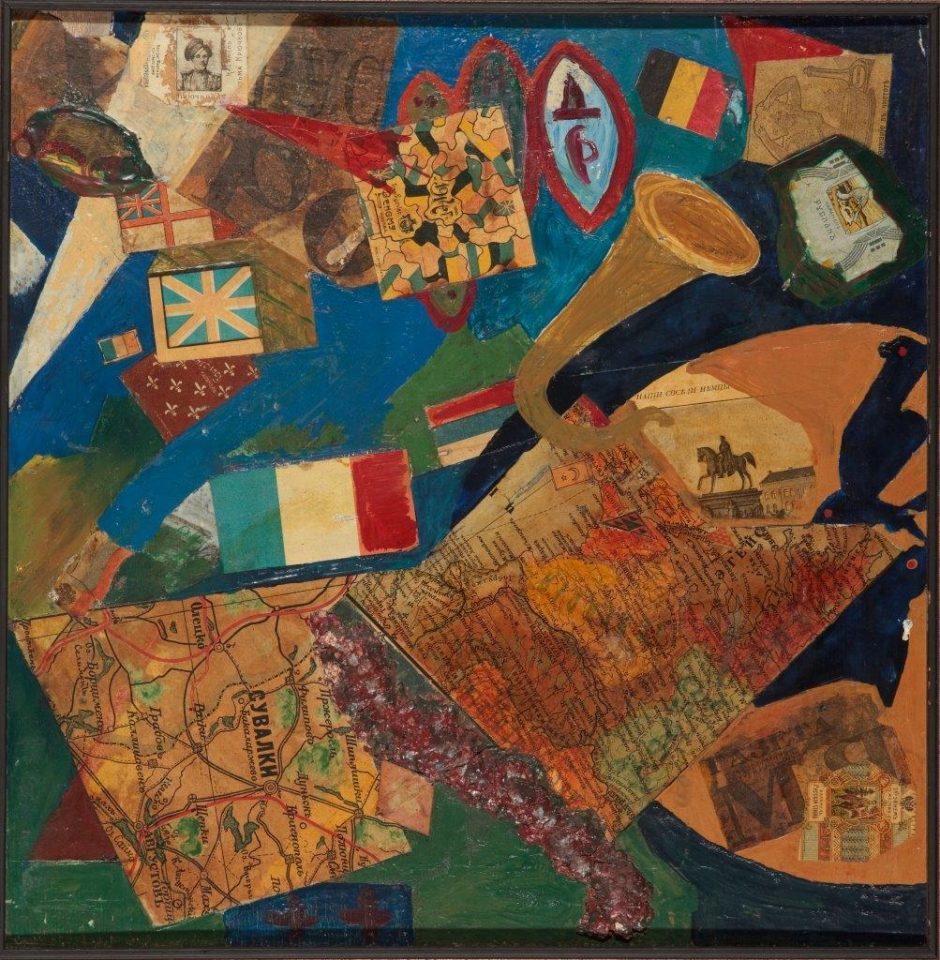
David Burliuk, Сollage on the theme of WWI, 1914-1915, Private collection
As Burliuk himself stated:
“A true artwork can be compared to a battery from which the energy of electrical suggestions comes. In each work, as in a theatrical action, a certain number of hours for admiring and looking at it is marked. Many works contain reserves of aesthetic energy for long periods, like mountain lakes, from which great rivers of influences tirelessly flow, and the sources do not dry out… ” (“Fragments from the Memories of a Futurist”, 1994).
The memoirs of this remarkable artist and poet were published as “Fragments from the Memories of a Futurist” in 1994. They are of great interest as a true testimony of this important protagonist of the European avant-garde movement. Vladimir Mayakovsky, the most prominent member of the Russian Futurist movement, remembered Burliuk as his real teacher, “the man who made me a poet”. (V. Mayakovski “Ja sam” [Я сам]. Moscow, 1978)
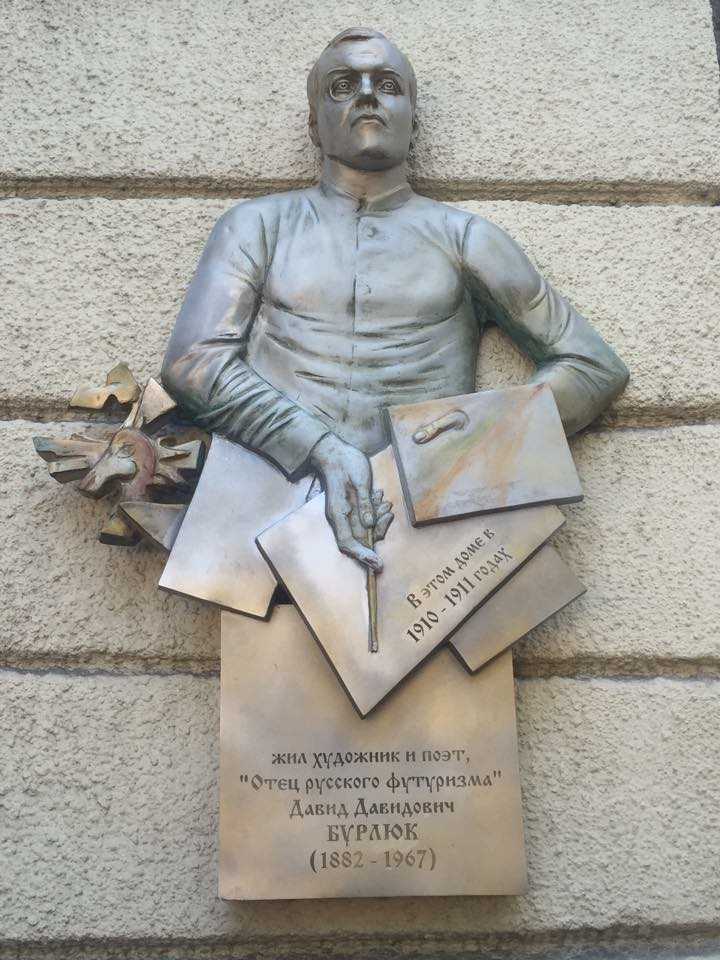
Memorial plaque to the “Father of russian futurism” [Otez russkogo futurisma] David Burliuk in Odessa, 2016
Мистецтво України. Давид Бурлюк
На початку квітня 2022 року, через війну в Україні, до команди Вілли Лібермана приєднався новий співробітник – Олександра Сакорська, яка до російського вторгнення десять років працювала в Національному музеї мистецтв імені Б. та В. Ханенків у Києві. За цю чудову можливість ми завдячуємо Фонду мистецтв Ернста фон Сіменса та його програмі фінансування України.
У цій серії блогів Олександра Сакорська познайомить нас з обраними українськими митцями від кінця ХІХ століття і до сьогодні. Другий текст блогу про українське мистецтво присвячено художній складовій творчості Давида Бурлюка (1882-1967).
Як і Макс Ліберман, Давид Бурлюк був провідним представником імпресіонізму на Батьківщині. Пізніше, однак, Бурлюк тяжів до авангардних проявів у мистецтві, розвивши неповторну живописну манеру, продовжуючи називати імпресіонізм «відправним пунктом оновлення мистецтва» (Д. Бурлюк. Голос імпресіоніста на захист живопису. 1908).
Український Батько Російського Футуризму
Давид Бурлюк (1882, Харківська губернія, Російська імперія – 1967, Лонг-Айленд, США) за життя був загальновизнаним «засновником російського футуризму» , і цей титул закріпилося за ним протягом усієї історії мистецтва. Бурлюк народився в Харківській губернії, нині на сході України, в багатодітній українській родині козацького походження. У дитинстві Давиду випадково влучив в око його рідний брат під час гри з іграшковим пістолетом. Згодом скляне око стало частиною фіромового стилю Бурлюка. До мистецтва хлопця тягнуло змалечку. У 1900–1901 рр. Давид навчався в Одеській Академії мистецтв, де «почав малювати і не міг зупинитися» (Бурлюк Д. «Фрагменти спогадів футуриста». СПб., 1994), повертаючись туди знову в 1910 році. Завдяки підтримці сім’ї Бурлюк мав змогу навчатися і за кордоном – в Мюнхенській академії мистецтв(1902), а пізніше – в Ательє Кормон, Париж (1904). Перші виставки Бурлюка відбулися в Харкові, Херсоні та Одесі протягом 1906-07 рр., і в 1908 році – в Києві. Там було продемонстровано його акварелі, пастелі та малюнки. Проводячи багато часу за кордоном, Бурлюк своєю творчістю не оминав Батьківщину, і ніколи повністю не забував своє коріння.
Лідер Нової Хвилі
Значущий внесок Давида Бурлюка – це консолідація творчих пошуків та згуртування митців-новаторів. Як активний учасник лівого, суперечливого на той час мистецького руху, Бурлюк злободенно назвав один із своїх мистецьких проектів «Ляпас суспільному смаку» (однойменний альманах, 1912). В Російській імперії Бурлюк став ядром мистецького руху, що мав на меті плекання нових способів самовираження у творчості. Пізніше всі учасники руху почали називати себе футуристами – «пророками нового часу, які бачать, чують, читають те, що ще нікому не доступно, але незабаром стане доступним всім», як це викристалізувалось з їх численних виступів та зі створеної «пророками» літератури.
Ця свіжа ідеологія віддзеркалювала радикальні зміни у суспільстві на початку 20 століття, і отримала загальне визнання як футуристичний рух, що розвивався одночасно в Італії та Російській імперії.
Роки в Еміграції
Під час Першої світової війни Бурлюк був непридатним до служби в армії через відсутність ока. У 1918 році Бурлюк дивним уникнув смерті під час погромів і розстрілів анархістів у Москві. Він одразу зрозумів, що в радянській Росії йому не місце. Тому всупереч і «в пику москалям» планував виставки своїх творів в Україні.
Невдовзі після російської революції Бурлюк став одним із перших послів російсько-українського авангарду за кордоном. У 1920 р. митець емігрував до Японії, де створював і продавав картини з місцевими мотивами, збираючи гроші на поїздку до США.
У 1922 р. він остаточно переїхав до Америки, де почав писати вірші та видавати книжки. З 1930 року Бурлюк видавав російсько-англійський журнал «Color & Rhyme», який проіснував до 1966 року. У США Бурлюк заручився підтримкою єврейської громади (те, що мати Бурлюка була єврейкою – маловідомий на сьогодні факт). У 1949 році Бурлюк рушає на південь Франції, щоб відвідати місця, де працював Вінсент Ван Гог (1853-1890). У 1967 році Давід Бурлюк посмертно став членом Американської академії мистецтв і літератури (разом з Леонардом Бернштейном, Генрі Міллером, Марселем Дюшаном та іншими).
Експерименти та Впливи
Бурлюк любив експериментувати і був одним з перших художників, які застосували техніку колажу, використовуючи різноманітні об’єкти, від склеєних шматочків фанери до шестерень і металевих пластин. У своїх роботах Бурлюк всіляко плекав фактуру. Характерним є також використання надяскравих кольорів в стилі «печворк», де просліджується поєднання кубізму і народного мистецтва. Загалом митець вважав живопис засобом комунікації, який може бути зрозумілим і цікавим для всіх, і тому має претендувати на універсальність, а не на елітарність.
Як зазначав сам Бурлюк: «Справжній витвір мистецтва можна порівняти з батарейкою, від якої йде енергія електричних навіювань. Кожній роботі, як і театральному дійству, відведена певна кількість годин для милування та розглядання. Багато творів містять запаси естетичної енергії на тривалі терміни, такі як гірські озера, з яких невтомно течуть великі ріки впливів, а джерела не висихають…» («Фрагменти спогадів футуриста», 1994).
Спогади цього видатного художника і поета були опубліковані під назвою «Фрагменти спогадів футуриста» в 1994 році. Вони особливо цінні як правдиві свідчення цього важливого героя європейського авангарду. Володимир Маяковський, найвидатніший представник російського футуристичного руху, згадував Бурлюка як свого справжнього вчителя, «людину, яка зробила мене поетом». (В. Маяковський «Я сам». Москва, 1978)